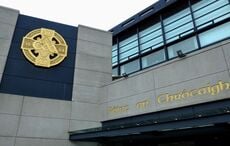The tragic killings of three people including a police officer by a deranged gunman in Chicago on the south side Monday night happened at one of the most famous Irish-founded hospitals in America.
"Massacre at Mercy Hospital” was the Chicago Tribune editorial after three victims were murdered in a mass shooting at Mercy Hospital, Chicago on Monday night. The gunman also died.
Dr. Tamara O'Neal, a physician in Chicago At Mercy Hospital, was shot six times today and killed by her ex-fiancee. pic.twitter.com/0dwqB9aGa2
— Shannon Watts (@shannonrwatts) November 20, 2018
The gunman murdered doctor Tamara O’Neal the hospital before storming the facility and killing a pharmaceutical assistant and police officer Samuel Jimenez (a father of two, who joined the police service only last year).
The gunman believed to have been the ex-fiancé of Dr. O'Neal was also killed but it is not yet clear if he took his own life or was shot by police.
The pharmaceutical assistant killed had been stepping out of an elevator when they were shot. Their name had not been released at the time of publication.
This brings the number of mass shootings in the United States in 2018 to 318.
Today, we mourn Chicago Police Officer Samuel Jimenez. His heroic actions saved countless lives. He ran toward danger. He ran toward those shots. He ran into fire. Selflessly.
Samuel Jimenez: altruism personified. #OfficerDown #NeverForget pic.twitter.com/7IDW4sJr6v
— Chicago Police (@Chicago_Police) November 20, 2018
The Irish nuns and Mercy, Chicago
The scene of the crime has a strong connection to the Irish community in America dating back to Famine times. Mercy Hospital, Chicago was founded by Irish nuns, according to the Sisters of Mercy official history in America.
In 1846, the needs of Irish immigrants and the insistent invitation of Rev. William Quarter, the city’s first Catholic bishop, drew the Sisters of Mercy to Chicago. The band of pioneers that set out from Pittsburgh under the guidance of Mother Frances Warde included Irish emigrants Sisters Agatha O’Brien, the appointed superior, novices Vincent McGirr and Gertrude McGuire, and postulants Eliza Corbett and Eva Schmidt – all under the age of 25.

When they arrived, Chicago was a small town on Lake Michigan, and its diocese was barely three years old.
Many “firsts” occurred with this pioneer group. They were the first and only religious women’s group in Chicago for ten years.
The sisters began “free” schools the morning after they arrived in Chicago. They soon established Chicago’s first academy, St. Francis Xavier Female Academy.
Blessings quickly multiplied. The sisters were soon teaching evening and catechism classes to adults. They sheltered young women; they visited inmates in the city jail; they nursed those afflicted by the frequent and deadly epidemics; and in the wake of these epidemics, they cared for orphans.
In 1850, the sisters began nursing at the Illinois General Hospital of the Lake Within two years, Mercy Hospital and Orphan Asylum was built and became Chicago’s first permanent general hospital.
Within eight years, all but one of the original group of sisters had died. However, others had come. They established foundations and ministries in Janesville, Milwaukee, Davenport, Iowa City, Ottawa, Aurora, Chicago’s South and West Side
Then, they woke the evening of October 8, 1871, to watch their 25 years in Chicago go up in smoke. Like other city residents that night, they fled for their lives and were busy safeguarding student boarders and women residents. The Chicago Fire reduced much of their property to rubble.

Old and new: Chicago Mercy, rebult after the fire.
All the buildings owned by the Sisters of Mercy on Wabash and Michigan Avenues were destroyed by the fire of 1871. The sale of these buildings was to be finalized the Monday after the Sunday fire. Although they had buildings on the south side of the city, they had to relocate many of their ministries.
St. Xavier Convent of Mercy Motherhouse was built after the fire: 1873 – 1901 at 29th and Wabash. Prominent award-winning architect, W.W. Boyington designed the Motherhouse which housed sisters, an Academy and other Mercy Services. After 1901 this became Mercy Business Club for Working Girls, housing and continued as the convent.
Social services were evident in Chicago as early as 1921 when there surfaced a dire need in the diocese for unwed mothers. George Cardinal Mundelein asked the sisters to take on this work of Mercy. Misericordia Home was opened to care for these young mothers. Later, this institution transformed its work to housing and care of handicapped children. In the 1970s, the ministry extended to housing older children and young adults with mental and physical limitations.
What Agatha O’Brien and her companions had sown in Chicago soil continues to flower in this new millennium. In the Chicago area, the Sisters of Mercy sponsor Saint Xavier University, Mother McAuley High School, and Mercy Hospital and Medical Center.

Mercy Hospital as it stands today.
The sisters also sponsor St. Catherine Residence in Milwaukee, safe and affordable housing for women in transition, and Mercy Hospital in Iowa City. own association with Misericordia Home.
Outreach to immigrants continues. Sisters wait and pray with immigrants who are in the process of being deported. They support their families.
The sisters today are still ministering in elementary, secondary, and higher education. They also serve as parish staff members, writers, artists, social workers, spiritual directors, board members, volunteers, healthcare providers, and much more. For such a tragedy to occur in one of the great Irish Catholic founded hospitals in America is a great shame and utterly at odds with the loving and caring mission of the Sisters of Mercy.




Comments